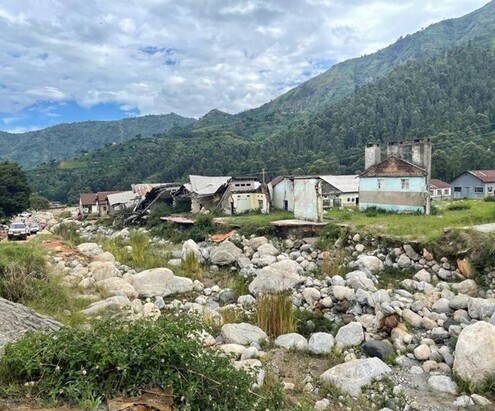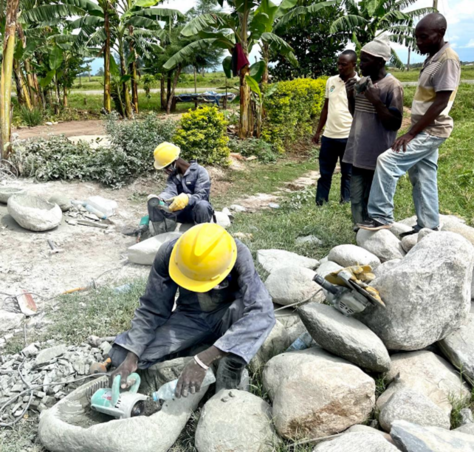How flooding incidents became an income-generating opportunity in Kasese District
Published on: 01/11/2023
By Rita Kiteme, Sociologist, Uganda. The writer works with the Albert Water Management Zone, one of the decentralised structures of the Ministry of Water and Environment serving the greater western region of Uganda.
This article is the writer's product after participating in the WASH storytelling write shop, organised and facilitated by IRC Uganda for regional partners, under the One For All alliance.
 As it majestically snakes its way down the Rwenzori Mountain ranges, River Nyamwamba brings life to the communities across nine sub-counties in Kasese District, as well as the greater Semliki, which is shared between Uganda and the Democratic Republic of the Congo (DRC). Yet, it is ironic that the same river that radiates life also brings so much destruction, ruin, and suffering.
As it majestically snakes its way down the Rwenzori Mountain ranges, River Nyamwamba brings life to the communities across nine sub-counties in Kasese District, as well as the greater Semliki, which is shared between Uganda and the Democratic Republic of the Congo (DRC). Yet, it is ironic that the same river that radiates life also brings so much destruction, ruin, and suffering.
Since the 1960s, flooding incidents of R. Nyamwamba and other rivers have, to varying degrees, devastated Kasese District and caused untold suffering to the people. The most recent flooding incident occurred in May 2020 when the river burst its banks during the heavy rainfall season resulting in loss of lives, displacement, infrastructure damage, and general disruption of people's livelihoods. Many families had to flee from their homes to areas that were less prone to floods.
Masereka Ibrahim, 33, chairperson of Kyondo Stone and Sand Miners Association, is one of the many affected persons. He lost trees worth about UGX 10 million to the floods. Indeed, Masereka is but one of the many residents who lost everything and had nowhere to begin after the floods.
Since October 2021, the Ministry of Water and Environment (MWE) has been implementing the Integrated Water Management and Development Project (IWMDP) to mitigate the impacts of future flooding in and around Kasese. Some of the implemented catchment measures include tree growing along the bare hills, riverbank stabilization, soil and water conservation technologies as well as promotion of alternative income-generating activities such as beekeeping, Horticulture, fruit growing, small-scale irrigation, coffee value chain development, establishment of ecotourism sites and skilling of the youth in stone crafting aimed at livelihood improvement of the affected communities.

Out of the skilling trainings that were conducted under IWMDP, skilling of the youth in stone crafting and designing was one of the most notable courses. This stone crafting and designing innovation targeted the youth who were now idle and unemployed having previously survived on the stone and sand mining activities along the riverbanks. It was enthusiastically embraced by the Kasese stone and sand mining groups such as Masereka's who had now lost their source of livelihood along the riverbank within the municipality.
As a training course, stone crafting and designing involved skilling the youth to learn how to use the stone boulders that had been washed by the floods as raw materials to make a range of clay, stone, and ceramic products such as plates, bowls, flowerpots, tiles, stools, kitchen cooktops, bathtubs, bathroom, and kitchen sinks and so many other related products. The training emphasized using the abundantly locally available stone boulders that had been washed downstream by the floods to turn them skillfully and innovatively into precious usable household items.Out of 200 youths who were trained in designing the stone products, at least 30 youths have mastered the art of crafting and designing the stone products and are now the trainers of trainers.
Today, the Kyondo Stone and Sand Miners Association produces a variety of precious products. They can sell their handcrafted products profitably at prices ranging from UGX20,000 to UGX 500,000.
"We used to earn about UGX 30,000 to 50,000 weekly from our sand mining activities. As skilled stone artisans, we now earn much more and there is hope for a better tomorrow," says Masereka Ibrahim, chairperson of, Kyondo Stone and Sand Miners Association.

Masereka however notes that there are high expenses incurred in the operation and maintenance of the stone crafting machines which interferes with production. He appeals for extra financial support to enable them to procure more machines to boost their production.
"Why should Ugandans spend a lot of money importing these items yet here in Kasese we are naturally gifted with all the raw materials for making better quality stone and ceramic products?" wonders Masereka.
With the enthusiasm and determination of organised groups like the Kyondo Stone and Sand Miners Association, Masereka is optimistic that with continued support, funding, and improved machinery and technology, Kasese District will in the near future undoubtedly become the epicenter for quality ceramics in Uganda and beyond.
At IRC we have strong opinions and we value honest and frank discussion, so you won't be surprised to hear that not all the opinions on this site represent our official policy.